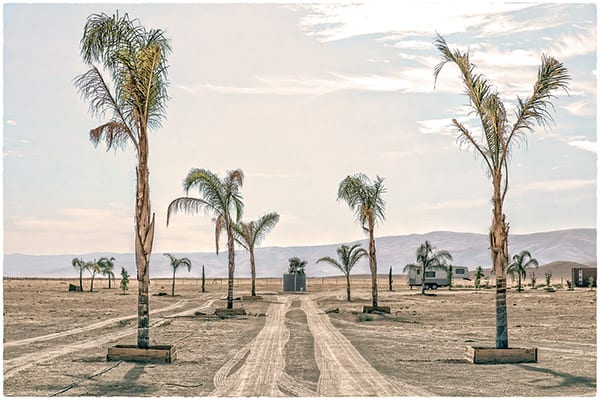

Ted Orland is one of The Image Flow’s favorite wandering photographers, with a love of photography and life that is truly infectious. “More often than not, I think, life is what happens while you‘re trying to set up your tripod,” says Ted.
He began his career as a young graphic artist working for famed designer Charles Eames and later served as photographer Ansel Adams’s assistant. Now a celebrated landscape photographer himself, Ted’s portfolio spans classical black and white photography, hand-colored photographs, and one-of-a-kind panoramas. He also co-authored the best-selling artists’ survival guide book Art & Fear: Observations on the Perils (and Rewards) of Artmaking.
This spring, Ted will lead a new landscape and travel photography workshop to California’s Salton Sea and Joshua Tree National Park along with Brian Taylor, artistic director of the Center for Photographic Art. Ted is an exceedingly funny companion, and he knows this area so well.
In his own words, Ted shares seven of his favorite photography subjects throughout this unique region of California to get us excited about this sure-to-be magical whirlwind trip!
Art is what happens when you’re on your way to the Designated Scenic Turnout. Such was the case here. I spotted this fairy ring of burnt palms from the freeway—a mile away—and spent a good fifteen minutes trying to figure out how to get from the nearest off ramp back to this point along the frontage road. And it was worth it!

After spending enough time among the astonishingly perfect artificial landscapes that pervade Palm Springs, one little question keeps surfacing: What would all those palms look like if you just left them alone? Enter the Coachella Valley Preserve—the best-kept secret in natural environmental preservation I’ve ever come upon in California or the West. Simply put, the Coachella Preserve, located in the desert north of Indio, is a natural oasis where palms grow and thrive naturally—without artificial irrigation—and remain utterly untouched by (and are now protected from) civilization. The result is a visual treasure unlike anything you will likely find anywhere else.

At some level, “desert landscaping” seems like an oxymoron—yet people continue to try their hand at it. The jury is still out as to whether such efforts are optimistic, idealistic or simply misguided, but you can certainly find examples that fall into each category. This particular trailer mansion was located along a side road near, well, actually, near the middle of nowhere. But in its own way it is kind of pretty, isn’t it?

Wind is surpassed only by sunlight and heat in its tangible effect on the desert landscape. Approaching Palm Springs from the L.A. to the west, or from Tehachapi to the north, you’ll pass hundreds of these truly monumental wind generators. Better yet, they’re often easily approachable since the freeways in desert areas seem to abound in parallel frontage roads, which not only provide closer views of these roadside attractions, but also make it easier to pull off the road and stop if you want to examine them more closely. And perhaps even take a photograph.

Among the many working-class roadside attractions that ring the Salton Sea, far and away the most important (if that’s the right word) is Salvation Mountain. Located near the town of Niland and far enough off the main road that few stumble upon it by accident, Salvation Mountain has long been attracting artists and other misfits. The “Mountain” is actually a 50-foot high bluff that was single-handedly decorated and molded by a lone New-Age Believer, Leonard Knight, over the course of two or three decades. I met Leonard several times, and he was the nicest, kindest guy in the world. He died a few years ago, but the site is still maintained by volunteers, and was recently accorded status on the National Registry of Folk Art Sites. It is, in its own unique way, unforgettable. The car detail pictured here is one of several such artifacts that have acquired the same characteristics as the site they inhabit. Maybe love is really all you need to make things happen.

The Big Attraction (literally speaking) in this neck of the non-woods is Joshua Tree National Park. It takes about an hour to drive from Palm Springs to the northern Park Entrance, but you can then spend the rest of the day happily meandering your way back through the park and out the southern entrance. Along the way you’ll be treated to a myriad of bizarre and occasionally monumental rock forms and desert flora. The cactus pictured here is Cholla, a very pretty little cactus whose barbs will stick to you like Velcro if you make the mistake of backing into one. Consider yourself forewarned.

One thing that’s never lacking in this lost corner of California is sheer open space. Vistas abound, and when the weather cooperates, it’s hard to go wrong photographically. In this case, traveling the loop road around the Salton Sea I had reached this random point when God pointed his finger down and said, “F/8 at 1/60, RIGHT NOW.” It helps to have your camera ready. Two minutes later the light was gone.
Join Ted to photograph these incredible places and others March 31 – April 3, 2016 in his workshop From Joshua Tree to the Salton Sea. This is a unique workshop with a small student – teacher ratio, sure to amaze and inspire you!

